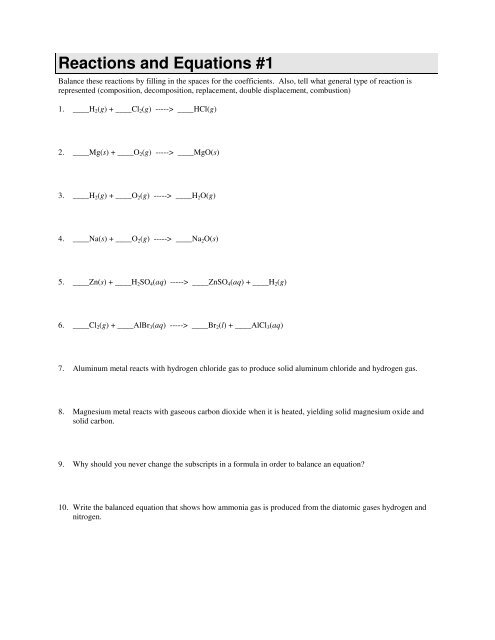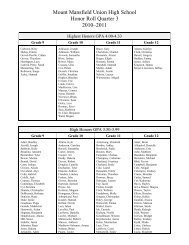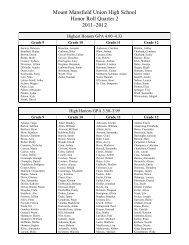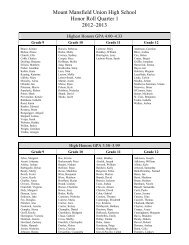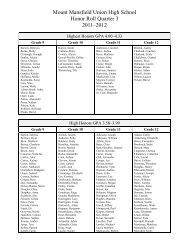You also want an ePaper? Increase the reach of your titles
YUMPU automatically turns print PDFs into web optimized ePapers that Google loves.
<strong>Reactions</strong> <strong>and</strong> <strong>Equations</strong> <strong>#1</strong><br />
Balance these reactions by filling in the spaces for the coefficients. Also, tell what general type of reaction is<br />
represented (composition, decomposition, replacement, double displacement, combustion)<br />
1. ____H2(g) + ____Cl2(g) -----> ____HCl(g)<br />
2. ____Mg(s) + ____O2(g) -----> ____MgO(s)<br />
3. ____H2(g) + ____O2(g) -----> ____H2O(g)<br />
4. ____Na(s) + ____O2(g) -----> ____Na2O(s)<br />
5. ____Zn(s) + ____H2SO4(aq) -----> ____ZnSO4(aq) + ____H2(g)<br />
6. ____Cl2(g) + ____AlBr3(aq) -----> ____Br2(l) + ____AlCl3(aq)<br />
7. Aluminum metal reacts with hydrogen chloride gas to produce solid aluminum chloride <strong>and</strong> hydrogen gas.<br />
8. Magnesium metal reacts with gaseous carbon dioxide when it is heated, yielding solid magnesium oxide <strong>and</strong><br />
solid carbon.<br />
9. Why should you never change the subscripts in a formula in order to balance an equation?<br />
10. Write the balanced equation that shows how ammonia gas is produced from the diatomic gases hydrogen <strong>and</strong><br />
nitrogen.
11. LiOH(aq) + H3PO4(aq) ----> H2O(l) + Li3PO4(aq)<br />
12. NH4Cl(s) + Mg(OH)2(s) -----> NH3(g) + H2O(l) + MgCl2(s)<br />
13. H2SO4(aq) + Ca(OH)2(s) -----> __________ + __________<br />
14. (NH4) 3PO4(s) + NaOH(s) -----> ________ + ________ + ________<br />
15. CaCO3(s) + HI(aq) -----> ________ + ________ + ________<br />
16. HCN(aq) + Mg(s) -----> ________ + ________<br />
17. Using any combination of the reagents listed here, write balanced equations showing how you could form the<br />
compounds in a - e.<br />
HCl Ca(OH)2 MgO Mg K2CO3 NH4Cl<br />
a. MgCl2<br />
b. H2<br />
c. NH3<br />
d. CaCl2<br />
e. CO2<br />
2
<strong>Reactions</strong> <strong>and</strong> <strong>Equations</strong> #2<br />
Write balanced equations for these. In the left margin, indicate rxn type.<br />
1. HgO(s) � Hg(l) + O2(g)<br />
2. Fe2O3(s) + C(s) � Fe(s) + CO(s)<br />
3. Cl2(g) + NaBr(aq) � Br2(l) + NaCl(aq)<br />
4. MgCO3(s) � MgO(s) + CO2(g)<br />
5. BaCl2(aq) + NaOH(aq) �<br />
6. NH4OH(aq) �<br />
7. H2CO3(aq) �<br />
8. C6H12O6 (S) + O2(g) �<br />
9. Silverware needs to be cleaned occasionally after its sits around <strong>and</strong> becomes tarnished. It becomes tarnished<br />
when sulfur, floating around in the air, reacts with the silver, becoming black silver sulfide. Sulfur molecules are S8.<br />
10. When propane gas (chemical formula: C3H8) burns, carbon dioxide <strong>and</strong> water vapor are the products.<br />
11. Model volcanoes are often made by kids in middle school for science fair projects that use baking soda <strong>and</strong><br />
vinegar as the "eruption". Baking soda is "sodium bicarbonate" or "sodium hydrogencarbonate" in chemicalese.<br />
Vinegar's active ingredient is acetic acid. One of the products (there are three products) is sodium acetate:<br />
NaC2H3O2. Think of the other two products <strong>and</strong> write the balanced equation.<br />
3
Some review, to keep your mind sharp <strong>and</strong> agile…<br />
12. Consider acetaminophen, C8H9NO2, the active ingredient in Tylenol.<br />
a. How many grams is 0.457 moles?<br />
b. If a Tylenol tablet contains 500 mg of the active ingredient, shown above, how many moles is this?<br />
c. How many moles of carbon atoms are there from #2?<br />
d. What is the mass percent of carbon in Tylenol?<br />
13. What is the difference between an emperical formula <strong>and</strong> a molecular formula?<br />
14. What is the mass of 8.0 moles of carbon dioxide?<br />
15. How many atoms of oxygen are in 4.5 moles of calcium hydroxide?<br />
16. An unknown solution is left in the lab. It has either barium-, silver-, or sodium nitrate present. What could you<br />
do to determine what solution has been left in the lab? Design a brief experiment. Write ppt rxns to show what you<br />
are considering.<br />
4
<strong>Reactions</strong> <strong>and</strong> <strong>Equations</strong> #3<br />
Here is some more practice. These are from the AP Chemistry test a few years ago.<br />
For each reaction, give the completed, balanced equation as well as the reaction type.<br />
(a) Solutions of zinc sulfate <strong>and</strong> sodium phosphate are mixed.<br />
(b) Solutions of silver nitrate <strong>and</strong> lithium bromide are mixed.<br />
(c) A stream of chlorine gas is passed through a solution of cold, dilute sodium bromide<br />
solution.<br />
(d) Excess hydrochloric acid solution is added to a solution of potassium sulfite.<br />
(e) Solutions of sodium iodide <strong>and</strong> lead nitrate are mixed.<br />
(f) A solution of ammonium hydroxide is added to a solution of iron (III) chloride.<br />
(g) A solution of hydrogen peroxide is heated.<br />
5
(h) A piece of solid bismuth is heated<br />
(i) A strip of copper metal is added to a concentrated solution of sulfuric acid.<br />
(j) A strip of copper is immersed in dilute nitric acid.<br />
(k) If 204.5 g of copper (II) nitrate is formed in the above reaction:<br />
1. How many moles are formed?<br />
2. How many atoms of oxygen are formed?<br />
3. What is the mass percent of nitrogen in the copper (II) nitrate?<br />
6
Even more reactions & equations<br />
1. Balance these reactions. Give reaction type for each, <strong>and</strong> complete each reaction, if it is not already completed.<br />
a. LiOH(aq) + H3PO4(aq) ----> H2O(l) + Li3PO4(aq)<br />
b. NH4Cl(s) + Mg(OH)2(s) ----> _________(g) + _________(l) + _________(aq)<br />
c. CaO(s) + HNO3(aq) ----><br />
d. CuCO3(s) + HBr(aq) ----><br />
e. BaCl2(aq) + NaOH(aq) ----> Ba(OH)2(s) + NaCl(aq)<br />
2. Write a balanced equation for the following descriptions of reactions.<br />
a. When metals react with acids, hydrogen gas <strong>and</strong> a salt are produced. The salt is formed from the metal cation<br />
<strong>and</strong> the acid anion. If the salt that is produced is soluble in water, it will be dissolved in the water that is<br />
produced. Write the equation that takes place between calcium metal <strong>and</strong> phosphoric acid solution.<br />
b. When metal carbonates are heated, carbon dioxide gas is produced along with the solid oxide of the metal.<br />
Write a balanced equation for the formation of barium oxide from barium carbonate. (Barium ions have a<br />
charge of +2.)<br />
c. Hydrogen peroxide (a liquid at room temperature) decomposes when exposed to sunlight. (That's why it<br />
always comes in brown opaque bottles.) Water is one product, <strong>and</strong> the other product is a gas that is able to<br />
relight a glowing splint. Write the equation showing the decomposition of hydrogen peroxide.<br />
3. Predict the products <strong>and</strong> balance the reactions. Give reaction type. REFER TO YOR NOTES!<br />
a. BaSO4(aq) + Ag(s) ----> ___________(s) + __________(aq)<br />
b. Mg(s) + HCl(aq) ----> __________(aq) + __________(g)<br />
c. Ca(NO3)2(aq) + Mg(s) ----> __________(aq) + __________(s)<br />
d. MgCO3(s) -----><br />
7
e. H2(g) + O2(g) ----><br />
f. Zn(s) + AgNO3(aq) ----><br />
g. C5H10(s) + O2(g) ----><br />
h. LiOH(aq) + H2SO4(aq) ----><br />
i. NH4Br(s) + NaOH(aq) ----><br />
j. MgCO3(s) + H2SO4(aq) ----><br />
4. Write the two half-cell reactions that take place when zinc metal is placed into a solution of silver nitrate, <strong>and</strong><br />
label them appropriately as "reduction" or "oxidation".<br />
8
<strong>Equations</strong> <strong>and</strong> <strong>Reactions</strong> Review<br />
1. Balance these reactions.<br />
a. MgCO3(s) ----> MgO(s) + CO2(g)<br />
b. Fe2O3(s) + C(s) ----> Fe(s) + CO(g)<br />
c. BaCl2(aq) + NaOH(aq) ----> Ba(OH)2(s) + NaCl(aq)<br />
2. Predict the products <strong>and</strong> balance the reactions. In the margin, give reaction type.<br />
a. ZnSO4(aq) + Mg(s) ----> ___________(s) + __________(aq)<br />
b. MgO(s) + HCl(aq) ----> __________(aq) + __________(l)<br />
c. Ca(s) + HNO3(aq) ----> __________(aq) + __________(g)<br />
d. Na2CO3(s) -----><br />
e. C(s) + O2(g) ----><br />
f. Zn(s) + AgNO3(aq) ----><br />
g. K(s) + O2(g) ----><br />
h. NaOH(aq) + H3PO4(aq) ----><br />
i. NH4Cl(s) + KOH(aq) ----><br />
j. (NH4)2CO3(s) + H2SO4(aq) ----><br />
3. Write a balanced equation for the following descriptions of reactions.<br />
a. Sodium metal burns with a bright yellow flame, producing solid sodium oxide.<br />
b. When potassium chlorate is heated in a test tube, it gives off a gas that is capable of relighting a glowing<br />
splint, <strong>and</strong> a white crystalline salt is left behind in the test tube.<br />
c. Nitrogen gas <strong>and</strong> hydrogen gas react at high pressure <strong>and</strong> temperature, producing ammonia gas. This is<br />
called the "Haber process".<br />
d. “Hexane” is a common non-polar solvent used in organic chemistry labs. When it burns, carbon dioxide<br />
<strong>and</strong> water vapor are the only products.<br />
9
4. Balance <strong>and</strong> type the following reaction, <strong>and</strong> then draw a fully labeled energy level diagram. Include bond<br />
making <strong>and</strong> bond breaking, activation energy, total energy, starting <strong>and</strong> ending materials. Endo- or exothermic?<br />
C2H5OH + O2 � CO2 + H2O<br />
5. Here is a partial list of elements in order of decreasing "activity". Determine if a reaction will occur. If so,<br />
write the completed, balanced equation.<br />
Metals: Li K Ca Na Mg Al Zn Cr Fe Ni Sn Pb H Cu Ag Hg Pt Au<br />
Non-metals: F Cl Br I<br />
a. Mg + AlCl3 �<br />
b. FeSO4 + Ni �<br />
c. NaI + Cl2 �<br />
d. HCl + Al �<br />
10
Practice Test: <strong>Reactions</strong> <strong>and</strong> <strong>Equations</strong><br />
You may use a calculator, your “ion sheet”, <strong>and</strong> a periodic table during this test.<br />
1. Complete the following reactions (if they react) <strong>and</strong> balance them.<br />
a. H2SO3(aq) + Al(OH)3(s) � ________(l) + ________(aq)<br />
b. NiCO3(s) __________(s) + __________(g)<br />
c. HBr (aq) + Mg (s) � _________(aq) + _______(g)<br />
d. C8H18(l) + O2(g) �<br />
e. CuCO3(s) + HClO3(aq) �<br />
f. ___________ (s) + ______________(s) � NH3(g) + H2O (l) + Na2SO4 (aq)<br />
3. Write the total reaction, <strong>and</strong> the oxidation <strong>and</strong> reduction half reactions that occur when Mg is burned in pure<br />
oxygen. ID what is oxidized, what is reduced.<br />
Total rxn:<br />
Oxidation rxn:<br />
Reduction rxn:<br />
Questions from the Labs <strong>and</strong> Demonstrations<br />
4. Dinitrogen oxide, or nitrous oxide (laughing gas) can be prepared by the thermal decomposition of<br />
ammonium nitrate. The other product is water. Write the balanced equation for this.<br />
One of the reactions you saw involved placing a piece of copper into an aqueous solution of silver nitrate. What<br />
would happen if a piece of silver were placed into an aqueous solution of copper nitrate?<br />
One of the reactions that you saw was the decomposition of hydrogen peroxide. In that reaction a gas is formed<br />
which relights a glowing splint. Write the balanced equation for the reaction.<br />
11
When limewater (a solution of calcium hydroxide) has a certain gas bubbled through it, a precipitate forms.<br />
Write the balanced equation that shows why limewater turns cloudy.<br />
5. Suppose that you are given a cube of magnesium metal of edge length 1.0 cm. Calculate the number of Mg<br />
atoms in the cube. Atoms are spherical in shape, therefore the Mg atoms in the cube cannot fill all the available<br />
space. If only 74% of the space inside the cube is taken up by Mg atoms, calculate the radius in picnometers of<br />
a Mg atom. The density of Mg is 1.74 g/cm 3 , <strong>and</strong> the volume of a sphere is<br />
with a "known" value.<br />
4 ⋅ r<br />
3<br />
3<br />
⋅π . Compare your value<br />
5. Draw a fully-labeled "energy level diagram" that shows the energy changes that take place when gasoline,<br />
C8H18, is burned in air. Include the balanced equation on your diagram. Label all parts properly.<br />
12
Many Chemical <strong>Reactions</strong> Demonstrations<br />
You will view numerous demonstrations during this unit. For each, you will briefly summarize what for each reaction, as<br />
well as write balanced equations <strong>and</strong> determine the reaction type. All the information will be recorded on this sheet.<br />
For each demonstrated reaction, hypothesize a formula <strong>and</strong> reaction type, describe the reaction, <strong>and</strong> write a completed,<br />
balanced equation for each. Label each reaction with the proper reaction type.<br />
# Reactants Hypothesis – may be equations, or<br />
description<br />
Actual description upon viewing<br />
1 Calcium <strong>and</strong> water<br />
Balanced eqn <strong>and</strong> rxn type<br />
2 Heating baking soda<br />
Balanced eqn <strong>and</strong> rxn type<br />
3 Sodium in water<br />
Balanced eqn <strong>and</strong> rxn type<br />
4 magnesium in<br />
hydrochloric acid<br />
Balanced eqn <strong>and</strong> rxn type<br />
5 magnesium in nitric<br />
acid<br />
Balanced eqn <strong>and</strong> rxn type<br />
6 chalk in sulfuric acid<br />
Balanced eqn <strong>and</strong> rxn type<br />
7 copper wire in silver<br />
nitrate solution<br />
Balanced eqn <strong>and</strong> rxn type<br />
8 combustion of<br />
methanol<br />
Balanced eqn <strong>and</strong> rxn type<br />
9 decomposition of<br />
hydrogen peroxide<br />
Balanced eqn <strong>and</strong> rxn type<br />
10 iron (steel wool) heated<br />
in pure oxygen<br />
Balanced eqn <strong>and</strong> rxn type<br />
11 ammonia <strong>and</strong><br />
hydrogen chloride<br />
Balanced eqn <strong>and</strong> rxn type<br />
13
12 sulfuric acid <strong>and</strong><br />
sucrose (table sugar)<br />
Balanced eqn <strong>and</strong> rxn type<br />
13 rapid oxidation of<br />
sucrose<br />
Balanced eqn <strong>and</strong> rxn type<br />
14 decomposition of<br />
ammonium dichromate<br />
Balanced eqn <strong>and</strong> rxn type<br />
15 heating copper<br />
carbonate<br />
Balanced eqn <strong>and</strong> rxn type<br />
16 heating potassium<br />
chlorate<br />
Balanced eqn <strong>and</strong> rxn type<br />
17 burning propane gas<br />
Balanced eqn <strong>and</strong> rxn type<br />
18 electric current passing<br />
through water<br />
Balanced eqn <strong>and</strong> rxn type<br />
19 aluminum <strong>and</strong><br />
iron(III) oxide<br />
Balanced eqn <strong>and</strong> rxn type<br />
20 heating copper(II)<br />
sulfate pentahydrate<br />
Balanced eqn <strong>and</strong> rxn type<br />
21 water <strong>and</strong> anhydrous<br />
copper(II) sulfate<br />
Balanced eqn <strong>and</strong> rxn type<br />
22<br />
23<br />
24<br />
14


